
- Many common factory ammo offerings began as wildcat cartridges.
- Reloading wildcat cartridges allows you to learn more about ballistics and load development.
- There is a satisfaction that wildcatters get from taking game with their own cartridge designs.
The word “wildcat” denotes something untamed, rebellious and maybe just a little bit dangerous. But that shouldn’t stop you from considering wildcat cartridges for hunting and shooting.
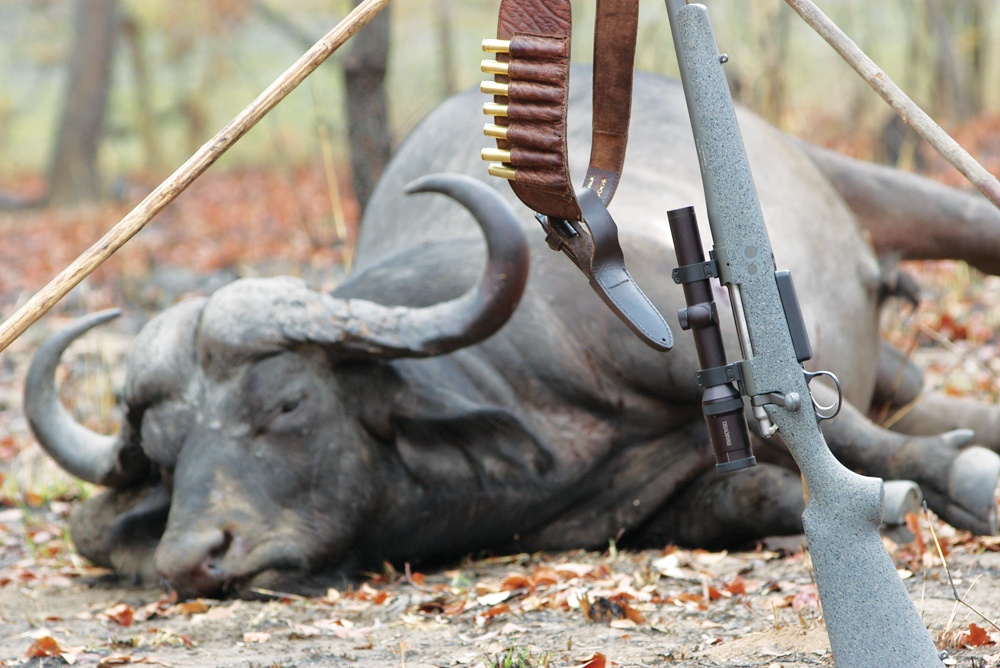
Just like the wildcat oil drillers who became legends, those gun guys who pioneered the wildcat cartridges were never afraid to ignore the naysayers. Wildcatters are the rebels, the guys who refuse to accept the status quo. They are the pioneers who stretch the boundaries to prove that there can be something more, something better.
Like most pioneers they rarely get the credit. Take for example the .22-250 Remington. Popular cartridge, right? But have you ever heard of Harvey Donaldson, Grosvenor Wotkyns, J.E. Gebby, John Sweany, or J.B. Smith?
Remington didn’t develop the .22-250; those guys did. They pioneered the early high speed .22 cartridges.
The Wotkyns version was called the .220 Wotkyns Original Swift (WOS) and was the forerunner to the .220 Swift, later introduced by Winchester. Gebby and Smith are most often credited with the version we call the .22-250 Remington today. They named it the .22 Varminter. Gebby even obtained a copyright on that name, but Remington took the design, added their name and got all the glory.
It’s the same with the .204 Ruger, 7mm Remington Magnum, .257 Roberts, .35 Whelen, the Winchester Short Magnums and a very long list of other popular cartridges. They were all developed by independent wildcatters and then “claimed” by a gun company as its own, often with the blessing of the wildcatter, but sometimes not. For the most part, the guys who developed the cartridges expected — and got — nothing. The exception might be the WSM cartridges, which are historical as the wildcats that ended up in court. It’s also what is slowly killing these cartridges.
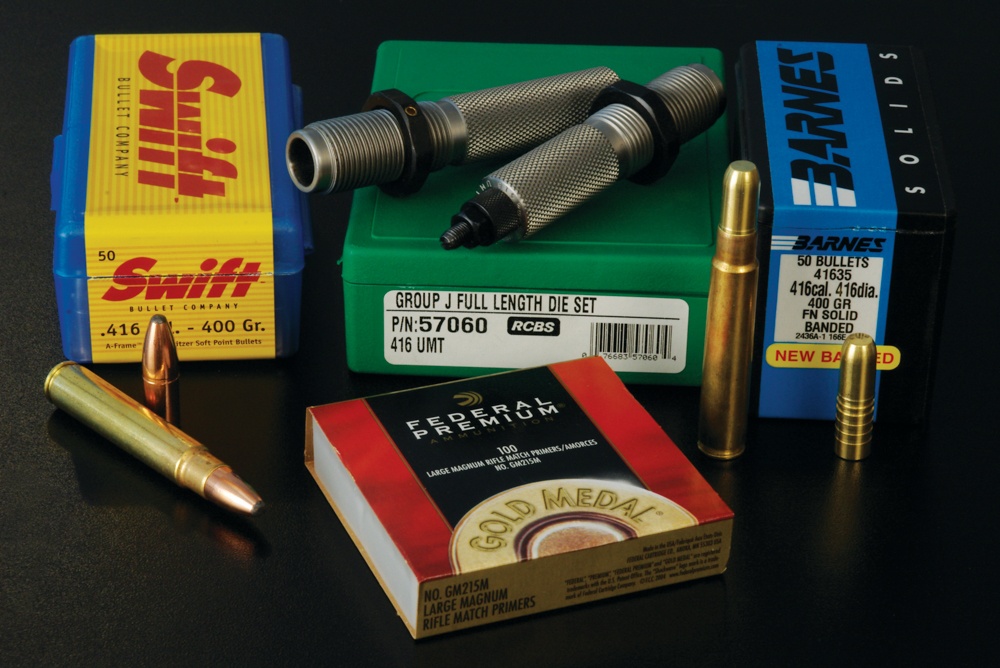
But that’s OK. Wildcat cartridge designers are not in it for the glory or to get rich. They do it for a love of guns and cartridges and for the challenge of doing something that’s never been done. Just like mountain climbers, they do it because “it’s there.”
For as long as I can remember I have been handloading and shooting many popular wildcats, like the .357 Herrett, 7mm TCU, .243 AI, .280 AI, .300 Whisper, .375 JDJ, and several others. I learned about case forming and load development by working with these cartridges, often in the very early years when there was little available data.
But like a lot of hard-core gun guys with a technical mind and a love of pushing the edges, I felt the need to create wildcat catridges of my own.
Nobody ever called me a conformist in anything I do, and I found the inspiration for my wildcats hiding that part of my rebel brain. I love .35-caliber rifle cartridges, even while the public does not. There has never been a hugely successful .35-caliber cartridge. The .35 Remington probably comes the closest, but it’s been dying a slow death for decades. So of course, that’s where I went for my first wildcat cartridge.
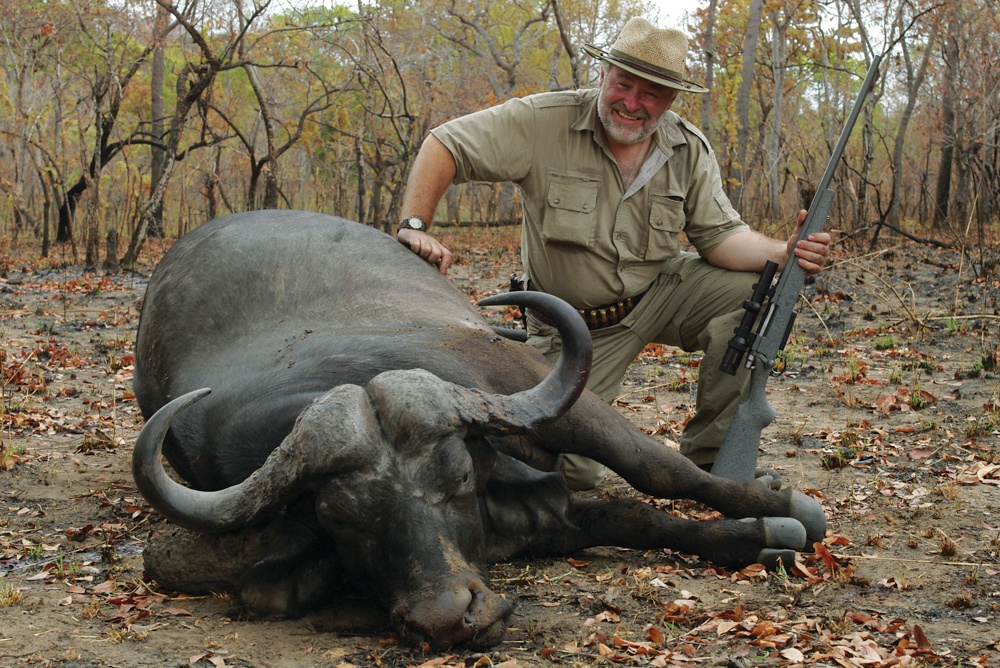
.358 UMT
Remington showed a select group of gun writers their new .300 Remington Ultra Mag in the fall of 1998, and the first thing I thought was that that big case would be awesome with a .358 bullet.
After considering a lot of case design possibilities I decided to keep it simple and necked the .300 Remington Ultra Mag case up to .358 with no other changes. It maintains the same body taper, the same 30-degree shoulder and the same datum line for headspacing. The only difference is a larger neck and the resulting shorter shoulder. I called the new cartridge the .358 Ultra Mag Towsley (UMT).
One pass of a well-lubed Remington case through the RCBS sizing die’s tapered expander button takes the neck from .30 to .35. Case loss during forming is all but non-existent. The expanding process shortens the case by about .018-inch, so I square the new case mouths and trim to 2.820-inch.
The rifle started as a stainless-steel Remington Model 700 chambered for .300 RUM, but only the action remains. I ordered a Krieger barrel with a 1:14 twist rate to stabilize 250-grain bullets. The barrel proved accurate and the bore is remarkably smooth and is easy to clean.
Gunsmith Mark Bansner turned the 24-inch barrel to a taper that measures .675˝ at the muzzle and then added six longitudinal flutes.
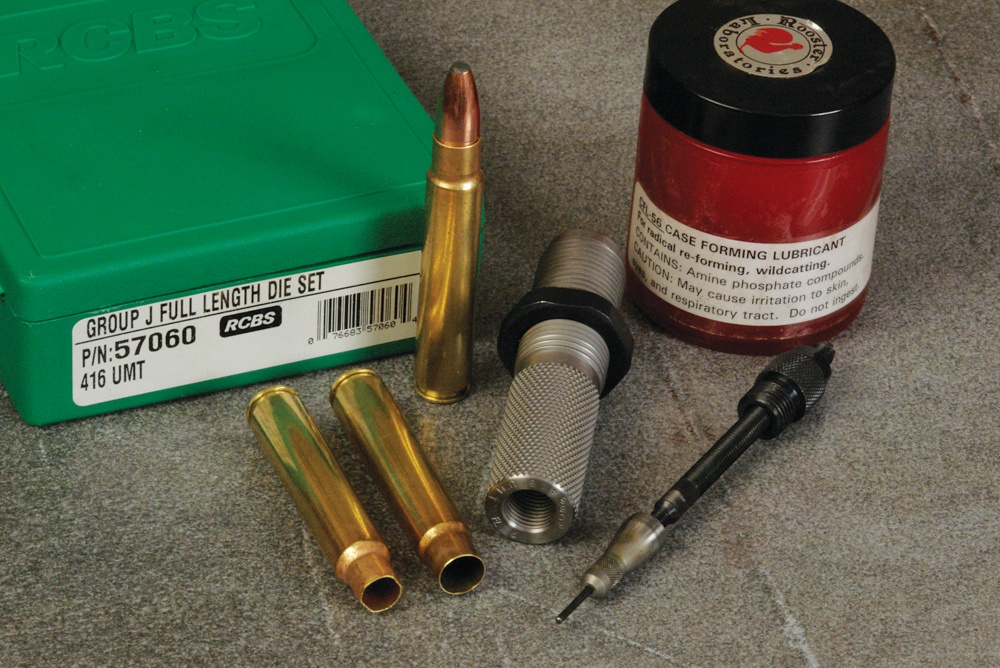
The limiting factor in overall cartridge length with any of the Ultra Mag cartridges is the rifle’s magazine. I knew the maximum workable cartridge length in this gun would be 3.675 inches. I made up some dummy cartridges with Nosler 250-grain Partition bullets and shipped them to Dave Manson Precision Reamers.
I asked Manson to configure the chamber reamer so it would provide a .010-inch jump to the rifling with the Nosler bullet seated to 3.675 inches. My other bullet choice at the time was a Barnes 225-grain X-bullet and, because of the difference in bullet profile, it would have a jump of about .030-inch when seated to the same overall length. This is fine because the Barnes X-Bullet requires a larger gap for peak performance.
Bansner chambered the barrel and installed it on the action, which had been polished and tuned. The entire barreled action was then bead-blasted for a matte finish.
I had him install a trigger from Timney Manufacturing Inc. and adjust it for a crisp 3-pound pull. I also asked him to change the safety so it would lock the bolt down when it is on (eliminating my pet peeve with current Model 700 rifles.)

Bansner then added one of his High Tech synthetic stocks, which proved to be one of the keys to making this rifle so user-friendly. The stock is designed so the butt is 90 degrees to the bore, which directs recoil straight back and helps to eliminate muzzle rise. As a result, your face is not beaten up by the rifle’s comb, as often happens with hard-recoiling rifles. The stock has a wide butt and a Pachmayr Decelerator recoil pad to further reduce felt recoil.
I conceived this to be a gun that would be lugged for miles up steep elk mountains or through the muskeg of Alaska. The weight needed to be balanced between heavy enough to shoot well under field conditions and light enough to not be hateful at the end of a long day.
When fitted with a Leupold Vari-X III 3.5-10 scope in Leupold two-piece mounts, the rifle weighs 8 pounds. This is on the light side for a rifle chambered in so powerful a cartridge, but the recoil is very manageable for an experienced shooter. Most people who shoot the rifle for the first time remark that the kick was a lot less than they anticipated.
I wanted a rifle suitable for hunting elk, big bears, moose and the larger African plains game in all the differing terrain in which they live. I wanted it to shoot flat so it could handle long shots, but also to hit hard and penetrate deep for big, tough game. This calls for heavy bullets with high sectional density and ballistic coefficient numbers. Bullets weighing 225 to 250 grains were the obvious choice.

With a large case capacity, heavy bullets usually call for slow-burning powder to push them and that proved true with the .358 UMT. It is not a particularly fussy cartridge to load, except that it does favor specific powders.
I initially thought it would work best with powders like IMR 4350 or IMR 4831, but they proved to be a bit too fast. IMR 7828 was by far the best powder tested, but H-1000 also works very well in some loads. With big charges of any powder, a hot primer is important. I used only Federal 215 primers.
The SAAMI spec for the .300 Ultra Mag cartridge is a mean average pressure of 65,000 psi, which I used as a guideline.
Some interesting things happened when I started shooting this cartridge. Most .358 bullets are designed for a much lower velocity and some of the best big game bullets that work so well in my .350 Rem. Mag. and .35 Whelen turned into varmint bullets with this cartridge, often fragmenting on impact.
The Barnes bullets were the exception. I started with a 225-grain XLC Coated X-bullet. Barnes didn’t make that one but coated some for me as a favor. After I wrote about it they got so many requests that they added it to their line. The XLC bullets are gone now, replaced by the Triple Shock. Today, my preferred bullet in this cartridge is the Barnes TSX 225-grain loaded with IMR 7828. This produces 3,165 fps and sub-inch groups.
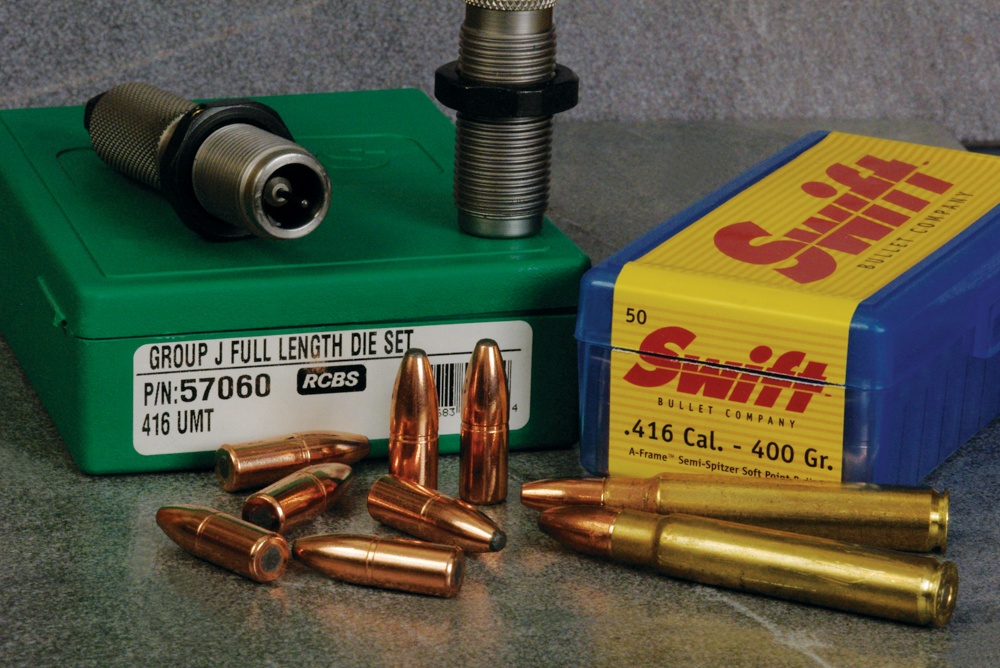
Another bullet that proved to work well is the Swift 250-grain A-Frame. When teamed with IMR 7828 it spits out the muzzle at 3,114 fps. Accuracy is nearly one hole for the best three-shot groups and always averages under minute-of-angle.
The steep o-give profile of this bullet allows it to be seated out close to the rifling lands, while the cartridge length remains short enough to fit into the magazine. The bullet expands rapidly and very big, so penetration is not as good as expected. But for elk-sized or smaller game this bullet does a great job.
I have used the .358 UMT while hunting a diversity of big game from springbuck to brown bears. It’s been to Africa with me twice and has accounted for a lot of African game, including a waterbuck and a diminutive red duiker that both made the record book.
I have used it a lot in North America as well while hunting game as diverse as mule deer to brown bears. The odd thing is that while I developed the gun for elk, I have not shot an elk with it! It’s been elk hunting, but never when the elk got the memo and remembered to show up.
The .358 UMT shoots flatter than a .300 Winchester with a 180-grain bullet and has more energy than a .416 Remington at any range.
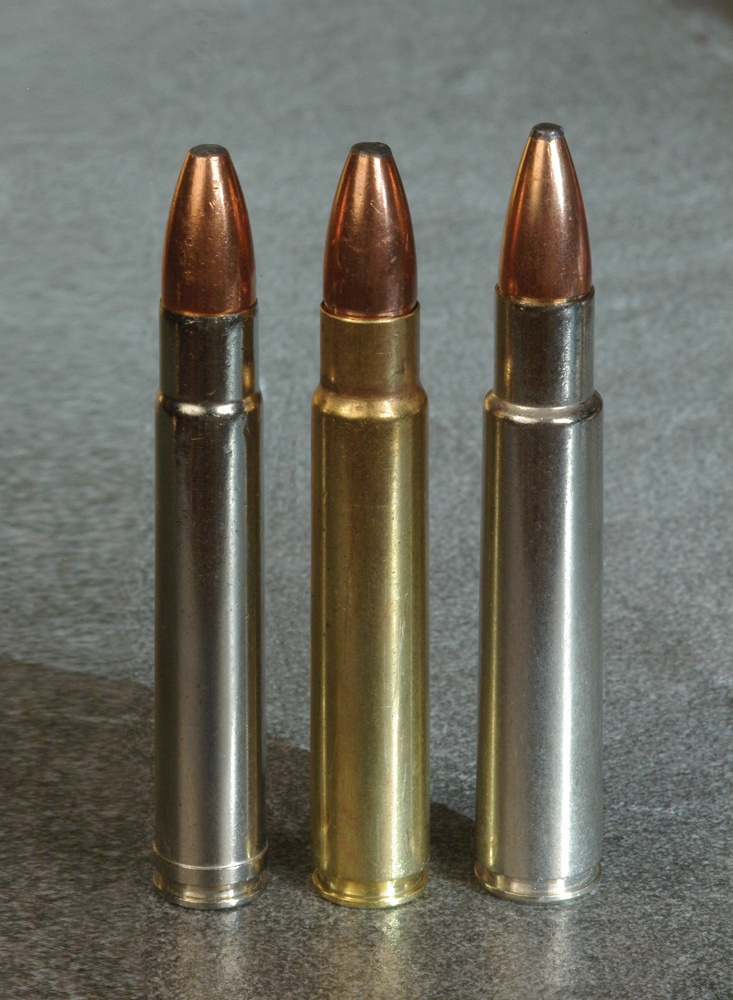
With a 250-yard zero the 225-grain Barnes TSX is 2.24 inches high at 100 yards and 3.26 inches low at 300 yards.
With the 250-grain bullet the .358 UMT produces 5,384 ft.-lbs. of muzzle energy. At 100 yards it still has more energy than the .375 H&H has at the muzzle and at 200 yards it retains 3,676 ft.-lbs., almost as much as the .338 Win. Mag. has at the muzzle.
.416 UMT
A few years later, I decided that if big is good, bigger is even better and I designed another cartridge in the UMT family — the .416.
The .416 UMT is not a complicated wildcat. It is simply a .375 Remington Ultra Mag necked up to take a .416 bullet. The shoulder angle, base to shoulder length, and datum line are all maintained the same as the .375 RUM. One pass of a well-lubricated .375 RUM case over a RCBS resizing die equipped with a tapered neck expander forms the case.
The only other thing I do is square up the case mouth with a case trimmer. This results in a case that is 2.825 inches, or about .025-inch shorter than the .375 RUM.
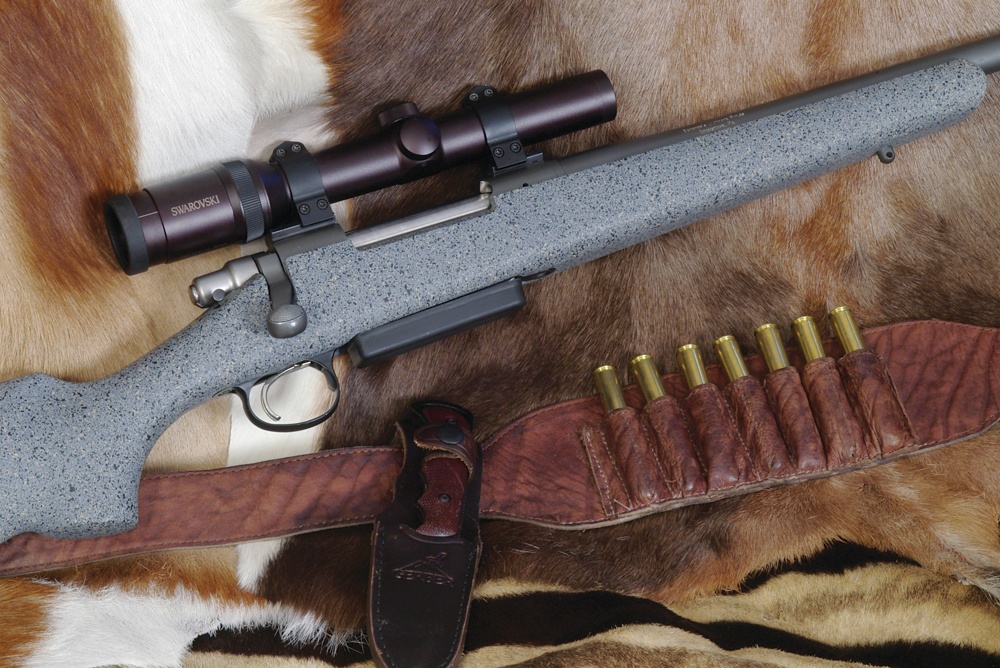
The case holds 120.2 grains of water to the top of the neck. The most popular .416 cartridges and the closest competitors are the .416 Remington, which holds 103.4 grains of water, and the .416 Rigby, which holds 129.6 grains.
The Ultra Mag class of cartridges were all designed to operate at a maximum average pressure of 65,000 psi, which is the same as the .416 Remington. The larger case capacity with equal pressure results in higher velocity with a given bullet weight. The .416 Rigby runs at about 52,000 psi, which keeps the performance lower when compared to case capacity.
Alliant RL 15 and Hodgdon H4350 were two of the best powders tested, and accuracy was excellent with groups averaging just over one inch with the best loads. With 400-grain bullets and RL15, velocity ran a bit over 2,500 fps.

There are a couple of boxes of this unique ammo someplace in the Dar es Salaam airport, as I was greeted on my way home by a Nazi masquerading as a KLM airline ticket agent. She would not let my bags on the plane because they were a few pounds overweight, even if I paid. I was headed home, the ammo was disposable, and the last time I saw it some guy was carrying it at arm’s length like it was a nuclear bomb.
A muzzle velocity of 2,500 fps is a considerable increase over the .416 Remington and .416 Rigby, which are cataloged at 2,400 fps but rarely have shown it on my chronograph. The realistic “real world” gain in velocity for the .416 UMT is about 150-200 fps over those two rivals when compared with guns of equal barrel length.
The performance on game is outstanding. The first shot of the safari dropped a warthog like he was hit with Thor’s hammer. My buffalo was hit with three Swift A-Frames and two Barnes Banded Solid bullets. All but the first shot exited and they all went through the vitals, including the first shot, which traveled end for end. It hit him in the ass and stopped under the skin on his neck. (Yes, I was aiming there. Don’t ask, it’s a long story.)
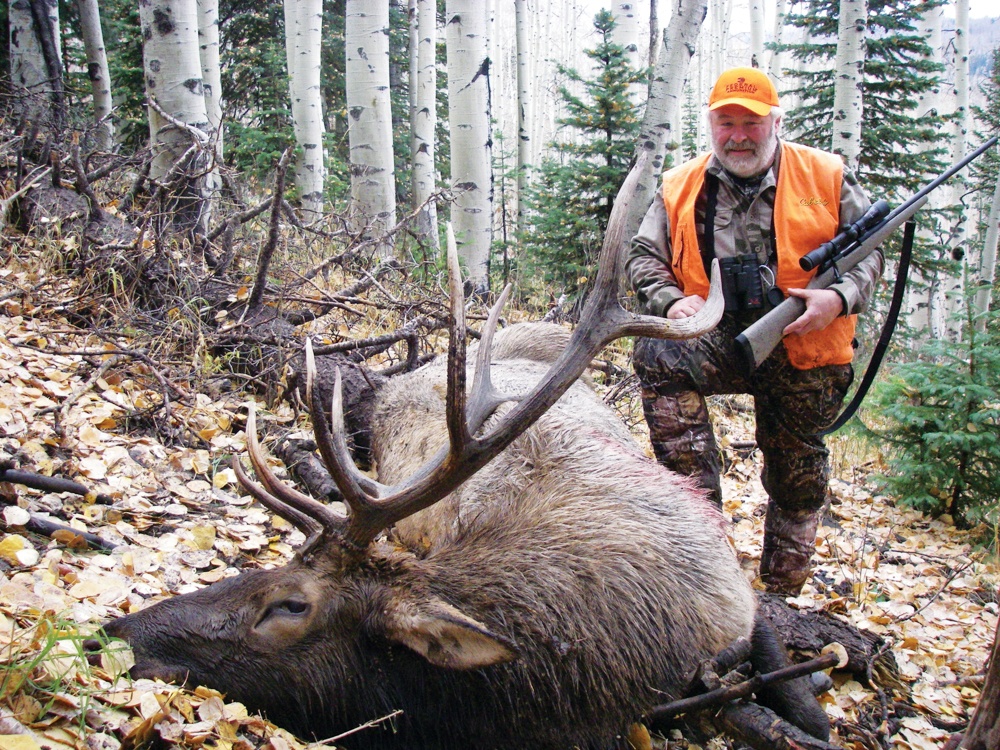
Mark Bansner built the gun on a Remington Model 700 action and fitted it with a 24-inch Lilja barrel. The extractor was changed to a larger design for a more positive grip on the case during extraction. I had Mark replace the safety with one that would lock the bolt shut. Mark coated the metal with his proprietary Ti-K-Cote polymer-based finish and fitted the barreled action to one of his High Tech Specialties Stocks. We added a staggered-feed magazine with a single-stack, center feed system from H. S. Precision so the gun would feed Barnes Solids reliably.
When I received the rifle from Mark it only weighed 8-1/2 pounds with a scope. With a brake it was a beast, but it was manageable. I took the brake off and this gun became a detached retina in waiting. I could shoot it, but it wasn’t fun.
It also ate high-quality scopes like they were snacks. So, I had Mark install three mercury recoil suppressors, two for the butt and one in the forend. The result was a gun that came in at a comfortable 10-1/4 pounds when equipped with a Swarovski 1.25-4X24 Habicht scope in Warne detachable mounts. Unlike some others, this scope has stayed together through several hundred shots.
The rifle weight is just about right for this type of gun. It’s still light enough to carry well on those long tracking jobs but is heavy enough to keep the recoil manageable. The biggest advantage of that in a dangerous game rifle is to be able to control the rifle for fast follow-up shots. With this gun I was now able to fire repeated shots very quickly.

.358 WSM
I was there when Winchester launched the .300 WSM and my first thought was to neck it to 35-caliber. In fact, I ordered a “donor” rifle that day. But due to some uncontrollable issues the project stalled for a couple of years and by the time I got my rifle somebody else had already done the cartridge and called it the .358 Sambar.
My rifle is based on a Winchester Model 70 short action rifle. Mark Bansner built the gun as he has several other custom rifles in the past, including both of my UMT wildcats.
The brass is easy to make by simply running .300 Winchester Short Magnum cases into a RCBS die with a tapered expander. I have tested several powders, but of those I tried, Aliant RL 17 is by far the best. It was developed for the short magnums and has certainly lived up to that in this cartridge. It gives me over 100 fps more velocity with a 225-grain bullet than any of the other powders I have tried to date.
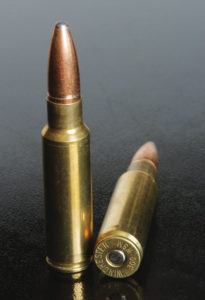
With a 225-grain bullet this cartridge easily produces 2,950 fps on my chronograph. That’s the same “advertised” velocity of a 180-grain bullet from a .300 Winchester Magnum. The 225-grain loads produce 4,400 ft.-lbs. of muzzle energy, which is almost 1,000 more than the .300 Winchester.
I have used Trophy Bonded 225-grain bullets to shoot elk, whitetail, and even antelope. The first was a bull elk at 250 yards. The bullet broke both shoulders and exited. You can’t ask for more than that.
The Barnes 225 TSX shoots close to one-half MOA in my gun and is deadly on any game I have shot. The last one was a big whitetail buck that was facing away from me at 15 yards. I caught the last rib and the bullet exited out his neck. To say the results were spectacular would be an understatement.
The 200-grain Barnes Tipped Triple Shock X bullets have a muzzle velocity of 3,100 fps and average .73-inch groups from my rifle at 100 yards. With a 250-yard zero this load is 2.55 inches high at 100 yards and 3.67 inches low at 300 yards.

This cartridge is not fussy and is very easy to handload. Recoil is very manageable. It’s an extremely versatile cartridge that is good for hunting any big game in North America. It’s not out of place for deer, and I would not hesitate to use it to hunt brown bear. It’s also a good choice for African plains game, including the huge, tough-to-kill eland.
I don’t kid myself that my wildcats will ever achieve commercial success like the .22-250 or 7mm Remington Mangum and that’s OK. I like that they are a bit oddball. While their level of performance is outstanding, the huddled masses will never recognize that. But a gun guy will see the truth and that’s what matters most to a wildcatter.
Editor’s Note: This excerpt is from Handloader’s Digest, 19th Edition available now at GunDigestStore.com
DISCLAIMER: Any and all loading data found in this article or book, including past or future editions, is to be taken as reference material only. The publishers, editors, authors, contributors, and their entities bear no responsibility for the use by others of the data included herein.

Next Step: Get your FREE Printable Target Pack
Enhance your shooting precision with our 62 MOA Targets, perfect for rifles and handguns. Crafted in collaboration with Storm Tactical for accuracy and versatility.
Subscribe to the Gun Digest email newsletter and get your downloadable target pack sent straight to your inbox. Stay updated with the latest firearms info in the industry.

![Best Concealed Carry Guns In 2025 [Field Tested] Wilson Combat EDC X9S 1](https://gundigest.com/wp-content/uploads/Wilson-Combat-EDC-X9S-1-324x160.jpg)


![Best 9mm Carbine: Affordable PCCs [Tested] Ruger Carbine Shooting](https://gundigest.com/wp-content/uploads/Ruger-Carbine-Shooting-100x70.jpg)
![Best AR-15: Top Options Available Today [Field Tested] Harrington and Richardson PSA XM177E2 feature](https://gundigest.com/wp-content/uploads/Harrington-and-Richardson-PSA-XM177E2-feature-100x70.jpg)
